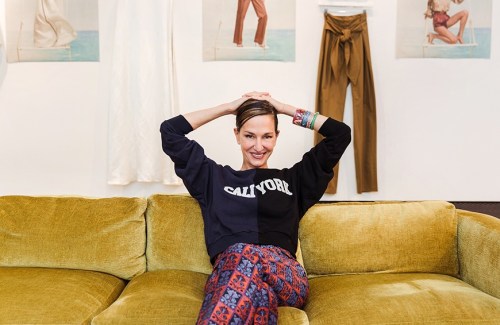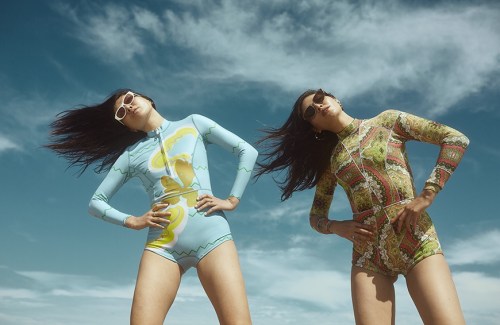30 years in, Cynthia Rowley talks the future of fashion
Fashion designer Cynthia Rowley has always designed with an active woman in mind. Now, 30 years after launching her label, the rest of the industry is embracing the idea. Here's what she predicts this could mean for the future of fashion.

At a time when many fashion designers seem fixated on the past, Cynthia Rowley is busy being present. “I try not to look back too much,” she says. “I try to really be in the moment.”
Her mindfulness practice is admirable and likely the reason why, despite decades of living in New York City and 30 years at the helm of her eponymous fashion label, the Illinois native is the epitome of chill, a feeling which reverberates throughout her line. To figure out why the signature blend of sport and style that Rowley calls “the DNA of the brand” feels more relevant today than ever, it’s important to start at the beginning of her career.
Rowley showed her first capsule collection in 1988 when the country’s fitness craze was at a crescendo: Let’s get physical wasn’t just a line from an Olivia Newton-John song, it was a mantra for the masses. At-home workouts were all the rage—so was wearing Spandex: leggings, bike shorts, bodysuits. Exercising was as much about endorphins as it was a lifestyle choice that permeated the popular culture—including fashion. Sound familiar?
Even if Rowley isn’t one for reflecting, the comparisons between then and now abound and it helps explain why the Cynthia Rowley “girl” has always been active—something her contemporaries have only started to consider relatively recently. (Rowley herself is an avid surfer and swimmer.) “I will say, [athleisure] never really existed until the last 10 years, max—five years really,” says Rowley. “It’s really taken off.” So much so that it’s now the fastest-growing category in the fashion industry, netting nearly $10 billion in sales last year.
“Now, it’s really about incorporating functional pieces into a total story.”
And now that wellness is becoming a way of life for an increasing number of women once again, Rowley predicts the lines between ready to wear and activewear will only blur further. “I think it’s hard to really differentiate your active life from your work life or your weekend life,” she tells me. “I think it’s all part of a healthy lifestyle that bleeds into every part of our lives. Now, it’s really about incorporating functional pieces into a total story.” The next chapter of which could easily be titled Activewear…but make it fashion.
Up to this point, we’ve seen fashion designers collaborate with sportswear companies, like Stella McCartney for Adidas, Victoria Beckham for Reebok, and Riccardo Tisci and Virgil Abloh for Nike, each one offering their take on that brand’s traditional workout clothes, lending it their sartorial stamp of approval. We’ve also seen activewear companies start designing for other facets of their customers’ lives by creating dresses and even jeans. Rowley envisions a future in which fashion designers create fully functional pieces that sacrifice nothing of their brand’s style aesthetic—and by extension, that of their customers. Precursors to this, in my mind, are the dresses Abloh created for Serena Williams at this year’s U.S. Open. Their trompe l’oeil one-shoulder silhouettes with tulle skirts were as revolutionary to the sport as the player who wore them.
This is an example in the extreme, but Rowley’s testing its real-world applications as well. “How do you take functional elements and put that into ready to wear? I have to say, I learned the hard way,” she admits. “You have to take the qualities you love in that garment and apply it to everyday wear. Part of the fun for me is being able to experiment and try things.”

For her, the fashion door has always swung both ways: borrowing elements of functional wear, from fabrics to shapes, for fashion pieces and vice versa. That means designing dresses inspired by flattering one-piece bathing suits and satin basketball shorts inspired by an old Richard Avedon photo of Kareem Abdul Jabar. It also includes swimwear, a segment she’s clearly personally passionate about—Rowley sends at least one wetsuit down the runway every season—you could easily wear on land in lieu of a top, as well as leggings and sweats—this month she launched a collab with luxe activewear boutique Bandier. “For spring, we’re making some really beautiful bike shorts that I think you’d wear out at night, and you can also work out in,” she says.
Even if one isn’t ready to show up at a tennis lesson in a tutu, or rock Rowley’s personal dream scenario—”I wish I could wear a wetsuit out with heels.”—this evolution of the industry speaks to a whitespace in the market that has, until now, gone unaddressed because few designers or brands have treated fashion as holistically as Rowley does. (One clear exception to this rule being Tory Burch, who launched her own activewear label in 2015.) “I try to think about everything in the same way,” she explains. “It’s the same philosophy: Just because you’re doing something active, why would you want to give up your own style?”
Why indeed.
Here’s how to wear throwback fashion trends like bike shorts and bodysuits circa 2018.
Sign up for the Well+Good SHOP Newsletter
Get exclusive deals on wellness, beauty, fitness, and food products that have been hand-picked by our editors.
Got it, you've been added to our email list.







